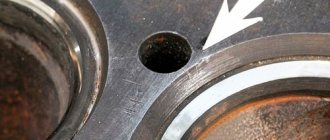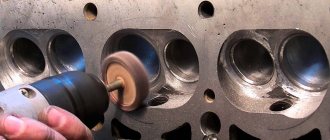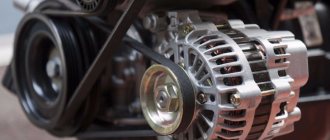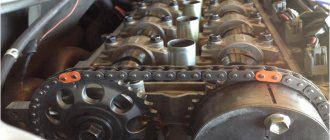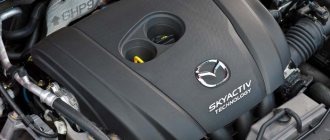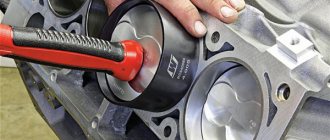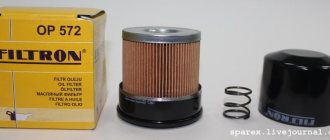A large family of inline six-cylinder engines, which were installed in the rear - and all-wheel drive TOYOTA cars. The first representative of the family - 1G-EU
(the only one of the series with 2 valves per cylinder) appeared back in 1979, but the maximum “heyday” of this engine family occurred at the end of the 80s, when four modifications of this engine were produced simultaneously.
A special feature of the series is that all engines belonging to it were equipped with an electronic distributed (multipoint) fuel injection system (EFI - Electronical Fuel Injection
).
Let's return to 1G-EU
.
This engine had very modest, by today's standards, characteristics: power 10 5 hp. at a rotation speed of 52,00 rpm, the maximum torque was 160 Nm at 4400 rpm. We installed it on various modifications of TOYOTA CROWN (GS 110/120 bodies); MARK II/CHASER/CRESTA (GX 60/70); SOARER (GZ10/20), from the entire 1G
, it is characterized by the greatest reliability, as well as ease of maintenance and repair.
It was discontinued in 1988, when it was replaced by 1G-FE
.
In parallel with the production of 1G-EU
, the TOYOTA concern in 1983 began producing a new, more “revolutionary” engine -
1G-GEU
, which became the first serial Toyota engine with four valves per cylinder.
This engine's head had two camshafts (one for the intake and one for the exhaust valves), each driven through its own gear by a common timing belt. Naturally, this design implied significant differences from the 1G-EU
- the engines had incompatible valve mechanisms, timing belts, cylinder heads, etc.
Thanks to boost and 4 valves per cylinder, engine power ranged from 140 hp at 6200 rpm (for CROWN) to 160 hp. at 6400 rpm (for MARK II/CHASER/CRESTA), torque increased to 186 Nm at 5200 rpm. It was installed on more expensive modifications of the same cars where the 1G-EU
(usually cars with such an engine had the inscription
TWIN CAM 24
on the trunk lid and radiator grille).
True, it was not on the TOYOTA CROWN GS110 (since this car was discontinued in 1983), but it was installed on the new SUPRA in the GA70 body, the production of which began in 1986. This engine was discontinued in 1988 when production of the 1G-GE
.
In 1986, production of two new engines began at once, both of which were supercharged: 1G-GZE
had a supercharger with a compressor driven from the engine crankshaft, and
the 1G-GTEU
was equipped with a turbocharger (the exhaust gases rotated the turbine).
As mentioned above, 1G-GZE
equipped with a mechanical compressor - an air blower, which was driven from the engine crankshaft through a belt.
This supercharging system has both advantages and disadvantages compared to gas turbine supercharging. The advantages of such supercharging systems include greater reliability (after all, turbines with rotation speeds of up to 200,000 rpm), better low-torque performance (the turbine operates effectively in a fairly narrow range of engine speeds: from approximately 3000 to 6000 rpm). min). The disadvantages of mechanical charging systems include, first of all, the lower efficiency of an engine equipped with such a system compared to a turbocharged engine (the useful energy of the exhaust gases is not used in any way, and the energy of the engine itself is spent on driving the compressor). The power of the 1G-GZE
was a respectable 160 hp.
at 6000 rpm (since 1988 - 170 hp at 6000 rpm), and torque increased to 230 Nm at 4000 rpm. This engine was intended primarily for the heavy CROWN (it was equipped with the “luxury” versions of the GS120 and GS130), which lacked the thrust of the naturally aspirated 1G-EU/FE
and
1G-GEU/GE
.
However, in addition to CROWN, it was decided to install such engines on the new MARK II/CHASER/CRESTA series (GX80 body, production began in 1988), where it existed until August 1990. On CROWN, it was installed until 1992. All cars with this engine are distinguished by good “torque” and have the SUPER CHARGER
(usually in addition to the inscription
TWIN CAM 24
) on the trunk lid and radiator grille; in addition, all
1G-GZE
were coupled
only
with an automatic transmission.
Let's move on to 1G-GTEU.
This turbocharged engine was the first of the Japanese engines to combine 4 valves per cylinder and turbocharging, which determined its high output: power of 185 hp.
at 6200 rpm, torque 245 Nm at 3200 rpm. A special feature of this engine was that it had two turbines (TWIN TURBO), which differed in optimal engine speeds, due to which the effective operation zone of turbocharging was expanded. These engines were intended for “hot” modifications of MARK II/CHASER/CRESTA in the GX70 body and for SOARER GZ10/20, as well as SUPRA GA70. Cars equipped with these engines were given the GT TWIN TURBO
.
Production of this engine was discontinued in 1988, when it was replaced by the 1G-GTE
.
In 1988, along with the change of generations of MARK II/CHASER/CRESTA, there was also a change of generations of the 1G engine. Engines with the letter U
after the dash.
Let's consider the first representative of the new family - 1G-GE
.
This engine was intended for modifications of the “medium sophisticated” MARK II/CHASER/CRESTA in the GX80 body, for CROWN in the GS130 body, it was also installed on the SOARER GZ20 and SUPRA GA70. Oddly enough, but compared to its predecessor, which was the 1G- GEU
, this engine lost power, which amounted to 150 hp, which is understandable, since it is achieved at 6200, and not at 6400 rpm as before.
The torque remained the same - the same and amounted to 186 N m, but at 5600 rpm, i.e. it was achieved at higher speeds. 1G-GE
was introduced until 1993, when SUPRA was discontinued in the 70th body.
On all machines with this engine, as in the case of 1G-GEU
there was also a
TWIN CAM 24
.
1G in history
became
1G-GTE
, which replaced its predecessor in the TOYOTA production program -
1G-GTEU
.
The power of the 1G-GTE
reached 210 hp.
at 6200 rpm, torque was 280 Nm at 3800 rpm. It was installed on “hot” modifications of MARK II/CHASER/CRESTA in the GX80 body (releases 1988 - August 1990), as well as on SOARER GZ20 and SUPRA GA70 (releases 1988 - 1991). Cars with this engine had the inscription - GT TWIN TURBO
.
Finally we got to 1G-FE
, which has been produced from 1988 to the present (though with quite large design changes).
This engine replaced the 1G-EU
, it was installed on the “standard” modifications of MARK II/CHASER/CRESTA in GX80/90 bodies, and it was also equipped with the “weakest” SOARER GZ20 and CROWN GS130/140.
A feature of the engine design is that it has 4 valves per cylinder, however, only one camshaft is driven from the timing belt, while the other shaft is driven from the first shaft through a gear (in the 1G-GE
, for example, each camshaft is driven through its own gear from timing belt).
Thanks to this design, the block head has a slightly smaller width (the so-called “twin cam with a narrow head”). Engine power was 135 hp at 5600 rpm, torque 180 Nm at 4400 rpm. Cars of the MARK II/CHASER/CRESTA family in the GX80 body usually had the following inscription on the rear window: 24 VALVE EFI
.
In 1996, with the arrival of the new MARK II/CHASER/CRESTA (GX100 body) 1G-FE
slightly modernized.
Its power was 140 hp, and the torque increased to 185 N m. However, in 1998, this engine was again modernized: then the production of a new sports model began - TOYOTA ALTEZZA. The engine was also made to match the car; now it is equipped with a gas distribution mechanism with variable phases (brand designation - VVTi
) and is one of the engines under the general name
BEAMS
.
Thanks to these technical tweaks, as well as increased rotation speed, engine power increased to 160 hp. at 6200 rpm, and the torque was 200 Nm at 4400 rpm. Naturally, there is no trace of the ease of repair and maintenance that the 1G-EU
... In addition to the ALTEZZA model, this engine continued to be installed on the MARK II/CHASER/CRESTA in the GX100 body, and the new model - MARK II (GX110), which was released began in 2000, also received this engine for installation on the cheapest modifications of the car. In 2001, production of the TOYOTA ALTEZZA GITA (station wagon based on the TOYOTA ALTEZZA) began, which is also equipped with this engine.
All 1G
very reliable in operation.
The advantages of these engines include: very low noise and vibration during operation, long service life (although this does not apply to turbocharging). The disadvantages of these engines include increased sensitivity to the quality of engine oil. Among the characteristic defects was the oil pressure sensor on 1G-FE
(especially 88 - 92 years of production), i.e.
when everything is in order with the lubrication system, and the sensor lamp is constantly on when the engine is running, which is why many owners of cars with 1G-FE
were seriously scared, counting on the upcoming serious repair. These engines have no other weak points.
Summary table with data for the 1G series
| engine | Years of manufacture | Power (hp)/at rpm | Torque (N*m)/at rpm | Compression ratio | Valves per cylinder |
| 1G-EU | 1979-88 | 105/5200 | 160/4400 | 9.2 | 2 |
| 1G-GEU | 1983-88 | 140/6200 — 160/6400 | 186/5200 | 9.1 | 4 |
| 1G-GZE | 1986-92 | 160/6000 — 170/6000 | 230/3600 | 8.0 | 4 |
| 1G-GTEU | 1986-88 | 185/6200 | 245/3200 | 8.5 | 4 |
| 1G-GE | 1988-92 | 150/6200 | 186/5400 | 9.5 | 4 |
| 1G-GTE | 1988-91 | 210/6200 | 280/3800 | 8.5 | 4 |
| 1G-FE | 1988-96 | 135/5600 | 180/4400 | 9.6 | 4 |
| — | 1996-98 | 140/5750 | 185/4400 | 9.6 | 4 |
| 1G-FE VVTi | 1998-2001 | 160/6200 | 200/4400 | 10.0 | 4 |
Data that can help with repairs and finding spare parts for the 1G-FE engine,
are given in the table (some of the characteristics may be common with other engines in the series):
| Parameter | Parameter value |
| Basic data (common to the entire series) | |
| cylinder diameter, mm | 75 |
| piston stroke, mm | 75 |
| number of cylinders | 6 |
| working volume, cm 3 | 1988 |
| Piston pin | |
| diameter, mm | 20 |
| length, mm | 61 |
| Piston rings | |
| height of the first compression ring, mm | 1,5 |
| height of the second compression ring, mm | 1,5 |
| oil scraper ring height, mm | 4,0 |
| Main bearings | |
| shaft journal diameter, mm | 55,001 |
| bed diameter, mm | 58,999 |
| liner width, mm | 19,2 |
| liner thickness, mm | 1,994 |
| Connecting rod bearings | |
| shaft journal diameter, mm | 41,998 |
| bed diameter, mm | 45 |
| liner width, mm | 19 |
| liner thickness, mm | 1,491 |
| Front crankshaft oil seal | |
| outer diameter, mm | 62 |
| internal diameter, mm | 45 |
| width, mm | 8 |
| Rear crankshaft oil seal | |
| outer diameter, mm | 100 |
| internal diameter, mm | 75 |
| width, mm | 13 |
| Camshaft oil seal | |
| outer diameter, mm | 50 |
| internal diameter, mm | 38 |
| width, mm | 8 |
| Oil pump seal | |
| outer diameter, mm | 30 |
| internal diameter, mm | 18 |
| width, mm | 7 |
| Thermal clearances in valves (on a cold engine) | |
| thermal clearance of the intake valve, mm | 0,20 |
| thermal clearance of exhaust valve, mm | 0,25 |
| Timing Belt | |
| number of teeth | 111 |
| tooth pitch, mm | 9,525 |
| belt width, mm | 25,4 |
The Toyota 1G-FE Beams engine was intended for Toyota Alteza (Lexus IS 200), Toyota Mark II, Toyota Chaser, Toyota Crown, Toyota Cresta. The engine appeared in 1998, as a result of deep modification and modernization of the engine. Peculiarities.
The 1G-FE Beams engine has acquired new systems that improve its performance. The engine received a VVT-i system (variable valve timing system), an electronic ignition system with individual coils for each cylinder. As for the mechanics, the design of the cylinder head has completely changed; a hydraulic timing belt tensioner, a new cylinder block and cylinder-piston group, and a different crankshaft have been installed. Engine disadvantages: if the timing belt breaks, the valve bends; problems with the oil pressure sensor. Almost all parts of the 1G-FE Beams and simple 1G-FE engines are not interchangeable, and on Beams they are significantly more expensive! With proper care, the service life of the 1G-FE Beams engine reaches 300 thousand km.
Engine characteristics Toyota 1G-FE Beams Mark 2, Alteza, Lexus IS 200
| Parameter | Meaning |
| Configuration | L |
| Number of cylinders | 4 |
| Volume, l | 1,988 |
| Cylinder diameter, mm | 75,0 |
| Piston stroke, mm | 75,0 |
| Compression ratio | 10 |
| Number of valves per cylinder | 4 (2-inlet; 2-outlet) |
| Gas distribution mechanism | DOHC |
| Cylinder operating order | 1-5-3-6-2-4 |
| Rated engine power / at engine speed | 117.7 kW - (160 hp) / 6200 rpm |
| Maximum torque/at engine speed | 200 N m / 4400 rpm |
| Supply system | Electronically controlled distributed injection |
| Recommended minimum octane number of gasoline | 92 |
| Environmental standards | — |
| Weight, kg | 160 |
Service
Servicing the Beams engine is generally no different from a simple 1G-FE. Changing the oil in the 1G-FE Beams engine.
Oil changes for Toyota Alteza, Mark 2, Cresta, Chaser, Crown, Lexus IS 200 with a 1G-FE Beams engine are carried out every 10 thousand km or 12 months (many advise changing the oil as often as possible, the engine is sensitive to its condition).
How much to pour: without filter replacement - 3.6 liters, with filter replacement - 3.8 liters (car with 2WD); without filter replacement - 4.0 liters, with filter replacement - 4.2 liters (cars with 4WD). Recommended oils according to API - not lower than SJ (SL), viscosity 10W-30, 5W-30, 5W-20 (depending on climatic conditions). Replacing the timing belt
is necessary every 100,000 km.
Remember that if the timing belt breaks on the 1G-FE Beams, the valves bend. Conventional spark plugs do not last long - 20 thousand km. The spark plug gap is 1.0-1.1 mm. Which spark plugs to use - Denso K20R-U11, NGK BKR6EYA11. the air filter
every 40 thousand km, otherwise there will be increased fuel consumption.
The coolant
is changed based on operating conditions, but usually every 2-3 years. The engine cooling system on vehicles with 2WD drive contains 6.5 liters of coolant, and on vehicles with 4WD – 7.2 liters.
The 1G FE engine is an in-line six-cylinder petrol engine that was designed and manufactured by specialists from the Japanese automaker Toyota in 1988. It replaced the 1G EU motor.
This motor combines simplicity of design, reliability and excellent dynamic performance. 1G FE engines were installed on a dozen different Toyota models. In 2007, this modification of the power unit was discontinued.
Maintenance schedule 1G FE 2.0 l/135 l. With.
The following intervals for replacing consumables are provided for the 1G FE engine:
- The timing belt must be replaced every 75,000 km, attachments after 50,000 km;
- It is recommended to adjust valve thermal clearances after 30,000 mileage;
- cleaning of the crankcase ventilation is provided every 2 years;
- The manufacturer recommends replacing the engine oil after 7,500 km along with the oil filter;
- the fuel filter should be replaced after 40,000 miles;
- The air filter must be replaced annually;
- after the coolant is packaged from the factory, the additives inside the antifreeze lose effectiveness after 40,000 km;
- the life of spark plugs in the DIS-4 engine system is 20,000 mileage;
- A burnout in the intake manifold is possible after 60,000 km.
The first version (1988 - 1998) is considered more reliable, the second version (1998 - 2005) is economical, high-torque and torquey. In rear-wheel drive cars, with filter replacement, you will need 4.0 liters of SJ/SL class lubricant exactly, and in all-wheel drive cars, 4.2 liters of 5W20, 5W30, 10W30 oil.
In the DIS-6 ignition system (since 1998), spark plugs, all other things being equal, will last longer than 30 thousand km instead of 20.
Specifications
| OPTIONS | MEANING |
| Years of manufacture | 1988 – 2007 |
| Engine weight, kg | 180 |
| Cylinder block material | cast iron |
| Supply system | injector |
| Type | in-line |
| Working volume | 2 |
| Power | 135 horsepower at 5600 rpm |
| Number of cylinders | 6 |
| Number of valves per cylinder | 4 |
| Piston stroke, mm | 75 |
| Cylinder diameter, mm | 75 |
| Compression ratio | 42530 |
| Torque, Nm/rpm | 180 -200/4400 |
| Environmental standards | EURO 3 |
| Fuel | AI 92-95 |
| Fuel consumption | 14 l/100 km in the urban cycle |
| Oil | SAE 0W-30 and higher |
| How much oil is in the engine | 42404 |
| When replacing, pour | 4 liters |
| Oil change carried out, km | 15 thousand |
| Engine life, thousand km - according to the plant - in practice | 400+ 500+ |
1G FE engines are installed on the Toyota Mark 2 X90, Soarer Z20, Altezza, Verossa, Lexus IS 200 and Crown GS130.
Peculiarities
The 1G engine has a displacement of two liters and develops a power of 135 horsepower. Thanks to the use of a reinforced cylinder head and a connecting rod group made of heavy-duty alloy, this engine has established itself as a fairly reliable and durable engine.
Without major repairs, 1G engines, provided they are properly maintained, can run about 500 thousand kilometers. It is not uncommon for cars with 1G FE to have driven more than a million kilometers, which indicates the excellent reliability of this power unit.
One of the features of this engine is the presence of a belt drive gas distribution system. However, no decrease in the reliability of the power unit is noted. Timing belt breaks are very rare, while the advantages of such a solution are obvious.
The gear belt drive has made it possible to significantly reduce the cost of motor production, simplify motor maintenance, and the power unit itself is compact in size. The use of a special interference belt drive system eliminates the impact of the pistons on the valves when the belt breaks. Thus, even in the event of such a serious breakdown, the car owner will be spared the need for expensive major repairs.
The gas distribution circuit of the engine is made using DOHC technology; it has four valves per cylinder. This allows you to optimize the operation of the power unit and make the most of its dynamic potential.
This motor is characterized by smooth operation over a wide speed range. Despite the fact that the engine shows its peak power at 4,400 thousand revolutions per minute, already at 1,500 revolutions the engine produces more than 80 percent of its power.
The cylinder block is cast from cast iron, which ensures maximum strength and thermal stability of the engine. It must be said that when casting the cylinder block and cylinder head, a special alloy reinforcement technology was used, which made it possible to reduce the thickness of the cylinder walls without losing the reliability and durability of the engine. This made it possible to reduce the weight of the six-cylinder engine, and thanks to its small size it can fit even in a small engine compartment. The weight of the power unit is 180 kilograms, which is a record low for six-cylinder engines.
Advantages and disadvantages
The original internal combustion engine design had several serious disadvantages:
- Oil may leak from under the oil seal, corroding the belt, causing it to slip and come off the pulley;
- The oil pressure sensor has a frankly weak design and a low resource.
But 1G-FE type 90 does not bend valves and is considered an indestructible, reliable, high-life power drive. Major repairs can be done in the garage with a minimum of tools.
After modernization, the engine became more expensive to maintain and repair. The VVTi system is sensitive to the quality of the lubricant; if the belt breaks, the pistons meet the valves, providing a major overhaul of the cylinder head.
Modifications
- Since August 1998, a new version of the motor has been released - 1G FE Beams. With VVT-i system and increased power of 160 hp. With. at 6200 rpm.
- In 1996, the 1G FE Beams engine was slightly restyled. The maximum power indicator increased to 140 horsepower, and the torque amounted to 185. The power characteristics were improved by reconfiguring the 1G FE Beams engine control unit and transferring the engine from 92 gasoline to AI 95. However, most car owners successfully operate their cars with this engine on A-92 gasoline, and there are no complaints about the reliability and dynamics of the car.
- In 1998, the engine was significantly changed. It received a new ShPG, an updated manifold with the ability to adjust geometry, an updated valve timing system, and a fully electronic throttle valve. Also on the 1G FE Beams the ignition system was changed.
A special feature of the modification of the 1G FE Beams engine is the absence of hydraulic valve clearance compensators, so for the 1G FE valves are adjusted every 20 thousand kilometers. Note that adjusting the 1G FE valves is not difficult and, with some experience, can be done independently by the car owner.
The restyling of the 1G FE Beams made it possible to increase engine power to 160 horsepower at 6200 engine speeds. The problem with the appearance of an oil leak from under the valve cover was eliminated and the oil pressure sensors were replaced, which also often failed and required expensive replacement.
Its only drawback is low power. In the mid-2000s, it was possible to easily extract more than 200 horsepower from two liters of displacement, while even in the restyled version this engine produced only 160 horsepower. It was due to obsolescence that this one was discontinued in 2007.
Toyota engine dead weight 1g fe. Cylinder head
Generally speaking, creating a bad straight-six is a difficult task! You need to make special efforts or not think with your head at all - Toyota succeeded in this twice: first, they reworked the “Yamaha” engine of the series to the point of complete absurdity and removed it from the market without recognizing the problem of bolts in the 7M-GTE
, and then they made the
1G
- I have seen dozens of broken engines, and on the Internet you can find a huge number of reports of unsuccessful repair attempts...
Plus, with 1998
In 2018, Toyota radically changed the design of the engine, adding all imaginable nasty things to it - a “crude” and half-thought-out
VVT-i
, a system for changing the geometry of the intake manifold (
ACIS ETCS
) and an unsuccessful distributorless ignition.
From this moment on, the engine deservedly bears the title “ shame of Toyota!”
", but let's take it in order.
IN 1979
year, Toyota engineers decided that they could already develop an in-line six on their own, without the help of Yamaha... The first representative of the
1G-EU
had only 2 valves per cylinder and produced 105 hp. at 5400 rpm. - the result is more than modest. Subsequently, all representatives of this family received 4 valves per cylinder. To save time, I will focus on the most common member of the family - engine 1 G-FE.
Until 1998, the biggest problem with this engine was the oil system. Firstly, the oil was knocked out through a low-quality oil pressure sensor (the recall program was not launched, despite the obviousness of the problem), and secondly, the oil pump was driven by the timing belt and had only one bearing. The belt was tensioned using a tensioner spring, which often led to excessive belt tension. In any case, the pressed end of the oil pump gear always had a skewed gap, which caused uneven wear. Also, any soot particles and solid oil contaminants accelerated this process and added new scratches - as a result, a drop in oil pressure and the inability to solve the problem by simply replacing the pump with a new one (wear occurred in the front engine cover).
The second disadvantage of a belt drive is a cold start. In winter, when the oil thickens, the load on the belt increases many times over, which can lead to the belt jumping several teeth or causing the teeth to grind down altogether. Fortunately, until 1998
years, the valves did not meet with the pistons when the timing belt broke,
after 1998
this “flaw” was eliminated... The third feature of the oil system is the presence of a long oil receiver, which slows down the oil supply after a cold start.
Fourth, there is an excess leaking oil seal in the timing belt casing.
It should be noted that owners usually claim that if the oil in this engine is changed more often (say, every 3000 km) and the most expensive oil is poured, then there are no problems with pump wear. This could be believed by someone who does not know that usually, back in Japan, the first owner actively pours mineral oil and violates replacement intervals - engines come to us already quite coked and worn out.
Next is the drive of service devices. I think Toyota engineers wanted to get into the Guinness Book of Records by making the longest belt for a serial 2-liter gasoline engine...
Or, perhaps, they simply loved Guinness beer - otherwise how to explain the fact that they drove the pump with the same belt.
What should the owner do when the generator whistles? Pray! Because if this belt breaks, then you can’t drive at all - you’ll be left without a generator and without a pump...
It is interesting that despite the above-described shortcomings, the owners of these engines actively praised them and created the illusion among themselves that this was almost the most reliable engine of all times.
Everything changed after 1998, when, in order to increase maximum power by 20 hp. marketers added an extremely poor design VVT-i
, as well as a variable intake manifold geometry system (
ACIS
), then an electronically controlled throttle valve (
ETCS
) and a distributorless ignition. In general, the engine was almost completely rebuilt - most of the parts are not interchangeable with the old one.
The engine existed in this form until 2005.
, when its production was completely discontinued.
If you have your own materials about the negative aspects of this motor, please send them to this address for publication.
Reader reviews:
27 04 10 19:18 You're an asshole. I've owned 1G-FE for 10 years - NO problems! (Novosibirsk)
28 04 10 06:47 I agree about oil leakage through the pressure sensor, but it can be easily treated, the main thing is not to miss the oil level, pull out the dipstick at least once a month and check the level. About the cold start is generally nonsense, the Mark 2 itself is equipped with just a beam, this winter the frosts in Novosibirsk were severe. There were no problems during a cold start, the main thing is to change the oil, in the summer you can use 10W40, in the winter you can fill it with 5W40 and there are no questions. At the moment, my car has 200 thousand km on the odometer. The VVT-I system does not cause any problems at all. (Novosibirsk)
28 04 10 23:57 Let's talk about 1G-FE Beams. You are wrong in many ways, and the main thing is that this engine is the worst in the Toyota line. Again, the operating conditions must be referenced. Anyway. Maybe you’ve seen a lot of dead engines from this line, and so have I. And I also agree about oil starvation as the cause of their death. I even agree that 1G engines in the 90s sweated oil, but here 100 percent depends on the oil. The tensioner roller does not lead to uneven load on the belt, don’t lie. The main reason for the death of these engines is cut-off in neutral, no matter how funny it may seem. Drivers are like that. The gear on the crankshaft is fixed with a cracker, which becomes deformed under such sharply increasing and decreasing loads. Over time, play occurs, which does not allow the oil pump to work correctly, gaps appear and the liners rotate. BUT until this moment, no matter how you force it, the engine will cover 250,000 km in any case. This happens on many Toyota, Honda, and Nissan engines. Euromotors have slightly different problems, but the result is often the same. Don’t vulgarize Toyota, this is our life, we relax on them, work, race, are proud and disappointed. I have several cars of my own, there is a Chaser, a Camry, a Karina, and there is also a Merc W202 and an Opel Omega Caravan. Everyone is good and bad in their own way. But in its price category, Toyota is the leader, whatever one may say. (Novosibirsk) Author's answer: Well, in Mercs the engines are every 250 thousand km. They don’t break due to the fault of the manufacturer?! Okay, then name the worst Toyota engine!
29 04 10 14:47 No, well, yes... Only Toyota has problems with engines... It seems that this is the reason why cars of this brand are so popular :) And even cars of the 90s still spill oil through the sensor on the roads of Russia a huge number...
Since the engine was produced in only one size, all G series engines are designated 1G
, and the same cylinder diameter and piston stroke of 75 millimeters.
1G was installed on cars:
- Lexus IS200
1G-EU
Japanese version, 1G-EU
, produced from 1979 to 1988. This engine had two valves per cylinder and one camshaft. Its power was 105-125 hp. With. (78-93 kW) at 5400 rpm, torque 157-172 Nm at 4400 rpm.
1G-FE
1G-GEU was installed on cars:
- August 1981-1985 Celica XX GA61
- August 1982-? Toyota Chaser/Mark II/Cresta
- August 1983-? Toyota Crown
- February 1983-? Toyota Soarer
1G-GE
Engine 1G-GE
succeeded by
1G-GEU
in 1988. Engine power dropped from 160 to 150 horsepower, the engine was installed on the same cars as 1G-GEU. It was produced for the Supra GA70 until 1993.
1G-GTE
24-valve DOHC engine 1G-GTE
became the first turbocharged engine in the series with two superchargers CT-12. There were three generations of this engine with air-to-air and air-to-water intercoolers, producing power from 185 to 210 hp. With. (138-157 kW) at 6200 rpm and torque from 234 to 275 Nm at 3800 rpm respectively. It was the most powerful engine in the G series. In May 1991, it was replaced by the 200 hp 1JZ-GE engine in most of the cars.
1G-GTE was installed on cars:
- 1986-1992 Supra MK3 ( GA70
chassis , Japan only) - 1988-1992
- Type - in-line
- Drive type - belt
(replacement every 100 thousand km. If the valve breaks, it
does not bend
.) - Number of cylinders - 6
- Valves per cylinder - 4
- Power type - injector
- Cylinder block material: cast iron
- Cylinder head material - aluminum
- Cylinder diameter - 75 mm
- Piston stroke - 75 mm
- Engine capacity - 1988 cc. cm.
- Compression ratio - 9
- Engine power - 135 hp. With. at 5600 rpm.
- Torque - 177 Nm at 4400 rpm.
- Fuel consumption -
city
12 l.
Track
7 .8 l.
Mixed cycle
- 10.8 l. - The specified oil consumption is up to 1000 g.
- used are DENSO K16R-U11, NGK BKR5EYA11.
- The recommended oil change interval is 5-7 thousand km. mileage
- Oil volume
in the system
- 4.2 liters - Recommended oils - 5W-30 5W-40 10W-30 10W-40
- The valve clearance check interval is 25 thousand km.
- Gaps - Intake - 0.2 mm. Release - 0.25 mm.
- The volume of coolant
in the system
is 6.5 liters. - Service life
with good oil and proper care
is 400 tons. km. and more.
One of the most successful Toyota engines, which stood on the assembly line for about 17 years. The engine was installed primarily on rear-wheel drive cars of the “above average” class. Released models with 1G-FE: , Crown, Soarer. The main advantages include the huge resource of the 1G-FE motor. There are several reasons for this:
The design of the crankshaft and its bed is such that the wear of its bearing journals is minimal, due to their large number.
Excellent balance of the in-line six-cylinder engine - as a result of which there is a minimum level of vibration and noise during operation. The 1G-FE engine at idle is not felt at all in the cabin, there is no sound or vibration. With the engine running, you can safely place a coin edge-on on the valve cover, and it will remain in that position! Even if you gently play with the throttle! (provided that all systems are in full working order: engine mounts, ignition system, spark plugs, armor wires, etc.)
Also, a big plus to the resource is the low overall boost of the 1G-FE motor. The Japanese removed 135 hp from the inline two-liter, six-cylinder layout. in the first version of this engine. In the 1G-FE restyling, Toyota engineers were able to increase power to 140 hp, with the introduction of an updated engine management system and redesigned injectors. Whatever one may say, even with this increase, this result of engine output is far from outstanding. Especially when you consider that the cylinder head is quite developed and has 4 valves per cylinder (24 in total).
General quality of Japanese engines of the 90s. Maintainability of 1G-FE. The engine is the same “millionaire from the 90s” from Toyota. The cylinder block is made of cast iron and has repair dimensions. Original spare parts are now available to order. Most repair these engines with duplicates and continue to operate the 1G-FE motor without problems.
There are no pronounced shortcomings, like the entire series of 1G motors. The entire line is characterized by increased requirements for good motor oil and compliance with its replacement intervals.
A common problem is difficult cold starts. In 90% of cases it is solved by adjusting the valves. It is also worth checking whether the injectors hold pressure. They can fill the engine with gasoline overnight and the 1G-FE will not start in the morning in the cold. The pre-restyling engine (before 90-91) 1G-FE was equipped with a cold start system, which Toyota later abandoned. It consists of an additional seventh cold start injector (it may also not hold rail pressure and flood the engine), which is installed in the intake manifold. And a thermal-time cold start relay. There are no duplicates, the original is expensive. Only a working used one. If all this does not help, look at: compression, check on the engine control unit (checked with a multimeter using a resistance table), spark plugs, wires, distributor, fuel pump, fuel filter, water in the tank, fuel rail check valves.
The main enemy of these engines is time. Whatever one may say, the youngest is 15+ years old. Even in the least running 1G-FE motor, all rubber seals lose their properties. Be it oil seals or oil seals. Another common occurrence is coking of oil scraper rings over time.
Many people experience unstable idle speed of 1G-FE. In these cases, you need to adjust the TPS, clean the throttle body and check the DTO.
Attachments are extremely reliable, but also suffer from time. Sensors, lambda probe, generator, starter, water cooling pump (pump) and so on.
The 1G-FE motor does not like moisture when washing the engine. The spark plug wells are quite deep, so after contactless washing it is better to thoroughly blow them out with air from the compressor. If the visco coupling gets into a deep puddle, it fills the entire engine compartment with water. The distributor is also easy to fill with water. So with washing and through deep puddles without fanaticism.
When buying a car with such an engine (certainly one of the best Toyota engines of those years), be prepared to service and/or replace all these little things. Fortunately, all spare parts for the 1G-FE motor are now available.
A large family of inline six-cylinder engines, which were installed in the rear - and all-wheel drive TOYOTA cars. The first member of the family - 1G-EU
(the only one of the series with 2 valves per cylinder) appeared back in 1979, but the maximum “heyday” of this engine family occurred at the end of the 80s, when four modifications of this engine were produced simultaneously.
A special feature of the series is that all engines belonging to it were equipped with an electronic distributed (multipoint) fuel injection system (EFI - Electronical Fuel Injection
).
Let's return to 1G-EU
.
This engine had very modest, by today's standards, characteristics: power 10 5 hp. at a rotation speed of 52,00 rpm, the maximum torque was 160 Nm at 4400 rpm. We installed it on various modifications of TOYOTA CROWN (GS 110/120 bodies); MARK II/CHASER/CRESTA (GX 60/70); SOARER (GZ10/20), from the entire 1G
, it is characterized by the greatest reliability, as well as ease of maintenance and repair.
It was discontinued in 1988, when it was replaced by 1G-FE
.
In parallel with the production of 1G-EU
, the TOYOTA concern in 1983 began producing a new, more “revolutionary” engine -
1G-GEU
, which became the first serial Toyota engine with four valves per cylinder.
This engine's head had two camshafts (one for the intake and one for the exhaust valves), each driven through its own gear by a common timing belt. Naturally, this design implied significant differences from the 1G-EU
- the engines had incompatible valve mechanisms, timing belts, cylinder heads, etc.
Thanks to boost and 4 valves per cylinder, engine power ranged from 140 hp at 6200 rpm (for CROWN) to 160 hp. at 6400 rpm (for MARK II/CHASER/CRESTA), torque increased to 186 Nm at 5200 rpm. It was installed on more expensive modifications of the same cars where the 1G-EU
(usually cars with such an engine had the inscription
TWIN CAM 24
on the trunk lid and radiator grille).
True, it was not on the TOYOTA CROWN GS110 (since this car was discontinued in 1983), but it was installed on the new SUPRA in the GA70 body, the production of which began in 1986. This engine was discontinued in 1988 when production of the 1G-GE
.
In 1986, production of two new engines began at once, both of which were supercharged: 1G-GZE
had a supercharger with a compressor driven from the engine crankshaft, and
the 1G-GTEU
was equipped with a turbocharger (the exhaust gases rotated the turbine).
As mentioned above, 1G-GZE
equipped with a mechanical compressor - an air blower, which was driven from the engine crankshaft through a belt.
This supercharging system has both advantages and disadvantages compared to gas turbine supercharging. The advantages of such supercharging systems include greater reliability (after all, turbines with rotation speeds of up to 200,000 rpm), better low-torque performance (the turbine operates effectively in a fairly narrow range of engine speeds: from approximately 3000 to 6000 rpm). min). The disadvantages of mechanical charging systems include, first of all, the lower efficiency of an engine equipped with such a system compared to a turbocharged engine (the useful energy of the exhaust gases is not used in any way, and the energy of the engine itself is spent on driving the compressor). The power of the 1G-GZE
was a respectable 160 hp.
at 6000 rpm (since 1988 - 170 hp at 6000 rpm), and torque increased to 230 Nm at 4000 rpm. This engine was intended primarily for the heavy CROWN (it was equipped with the “luxury” versions of the GS120 and GS130), which lacked the thrust of the naturally aspirated 1G-EU/FE
and
1G-GEU/GE
.
However, in addition to CROWN, it was decided to install such engines on the new MARK II/CHASER/CRESTA series (GX80 body, production began in 1988), where it existed until August 1990. On CROWN, it was installed until 1992. All cars with this engine are distinguished by good “torque” and have the SUPER CHARGER
(usually in addition to the inscription
TWIN CAM 24
) on the trunk lid and radiator grille; in addition, all
1G-GZE
were coupled
only
with an automatic transmission.
Let's move on to 1G-GTEU.
This turbocharged engine was the first of the Japanese engines to combine 4 valves per cylinder and turbocharging, which determined its high output: power of 185 hp.
at 6200 rpm, torque 245 Nm at 3200 rpm. A special feature of this engine was that it had two turbines (TWIN TURBO), which differed in optimal engine speeds, due to which the effective operation zone of turbocharging was expanded. These engines were intended for “hot” modifications of MARK II/CHASER/CRESTA in the GX70 body and for SOARER GZ10/20, as well as SUPRA GA70. Cars equipped with these engines were given the GT TWIN TURBO
.
Production of this engine was discontinued in 1988, when it was replaced by the 1G-GTE
.
In 1988, along with the change of generations of MARK II/CHASER/CRESTA, there was also a change of generations of the 1G engine. Engines with the letter U
after the dash.
Let's consider the first representative of the new family - 1G-GE
.
This engine was intended for modifications of the “medium sophisticated” MARK II/CHASER/CRESTA in the GX80 body, for CROWN in the GS130 body, it was also installed on the SOARER GZ20 and SUPRA GA70. Oddly enough, but compared to its predecessor, which was the 1G- GEU
, this engine lost power, which amounted to 150 hp, which is understandable, since it is achieved at 6200, and not at 6400 rpm as before.
The torque remained the same - the same and amounted to 186 N m, but at 5600 rpm, i.e. it was achieved at higher speeds. 1G-GE
was introduced until 1993, when SUPRA was discontinued in the 70th body.
On all machines with this engine, as in the case of 1G-GEU
there was also a
TWIN CAM 24
.
1G in history
became
1G-GTE
, which replaced its predecessor in the TOYOTA production program -
1G-GTEU
.
The power of the 1G-GTE
reached 210 hp.
at 6200 rpm, torque was 280 Nm at 3800 rpm. It was installed on “hot” modifications of MARK II/CHASER/CRESTA in the GX80 body (releases 1988 - August 1990), as well as on SOARER GZ20 and SUPRA GA70 (releases 1988 - 1991). Cars with this engine had the inscription - GT TWIN TURBO
.
Finally we got to 1G-FE
, which has been produced from 1988 to the present (though with quite large design changes).
This engine replaced the 1G-EU
, it was installed on the “standard” modifications of MARK II/CHASER/CRESTA in GX80/90 bodies, and it was also equipped with the “weakest” SOARER GZ20 and CROWN GS130/140.
A feature of the engine design is that it has 4 valves per cylinder, however, only one camshaft is driven from the timing belt, while the other shaft is driven from the first shaft through a gear (in the 1G-GE
, for example, each camshaft is driven through its own gear from timing belt).
Thanks to this design, the block head has a slightly smaller width (the so-called “twin cam with a narrow head”). Engine power was 135 hp at 5600 rpm, torque 180 Nm at 4400 rpm. Cars of the MARK II/CHASER/CRESTA family in the GX80 body usually had the following inscription on the rear window: 24 VALVE EFI
.
In 1996, with the arrival of the new MARK II/CHASER/CRESTA (GX100 body) 1G-FE
slightly modernized.
Its power was 140 hp, and the torque increased to 185 N m. However, in 1998, this engine was again modernized: then the production of a new sports model began - TOYOTA ALTEZZA. The engine was also made to match the car; now it is equipped with a gas distribution mechanism with variable phases (brand designation - VVTi
) and is one of the engines under the general name
BEAMS
.
Thanks to these technical tweaks, as well as increased rotation speed, engine power increased to 160 hp. at 6200 rpm, and the torque was 200 Nm at 4400 rpm. Naturally, there is no trace of the ease of repair and maintenance that the 1G-EU
... In addition to the ALTEZZA model, this engine continued to be installed on the MARK II/CHASER/CRESTA in the GX100 body, and the new model - MARK II (GX110), which was released began in 2000, also received this engine for installation on the cheapest modifications of the car. In 2001, production of the TOYOTA ALTEZZA GITA (station wagon based on the TOYOTA ALTEZZA) began, which is also equipped with this engine.
All 1G
very reliable in operation.
The advantages of these engines include: very low noise and vibration during operation, long service life (although this does not apply to turbocharging). The disadvantages of these engines include increased sensitivity to the quality of engine oil. Among the characteristic defects was the oil pressure sensor on 1G-FE
(especially 88 - 92 years of production), i.e.
when everything is in order with the lubrication system, and the sensor lamp is constantly on when the engine is running, which is why many owners of cars with 1G-FE
were seriously scared, counting on the upcoming serious repair. These engines have no other weak points.
Summary table with data for the 1G series
| engine | Years of manufacture | Power (hp)/at rpm | Torque (N*m)/at rpm | Compression ratio | Valves per cylinder |
| 1G-EU | 1979-88 | 105/5200 | 160/4400 | 9.2 | 2 |
| 1G-GEU | 1983-88 | 140/6200 — 160/6400 | 186/5200 | 9.1 | 4 |
| 1G-GZE | 1986-92 | 160/6000 — 170/6000 | 230/3600 | 8.0 | 4 |
| 1G-GTEU | 1986-88 | 185/6200 | 245/3200 | 8.5 | 4 |
| 1G-GE | 1988-92 | 150/6200 | 186/5400 | 9.5 | 4 |
| 1G-GTE | 1988-91 | 210/6200 | 280/3800 | 8.5 | 4 |
| 1G-FE | 1988-96 | 135/5600 | 180/4400 | 9.6 | 4 |
| — | 1996-98 | 140/5750 | 185/4400 | 9.6 | 4 |
| 1G-FE VVTi | 1998-2001 | 160/6200 | 200/4400 | 10.0 | 4 |
Data that can help with repairs and finding spare parts for the 1G-FE engine,
are given in the table (some of the characteristics may be common with other engines in the series):
| Parameter | Parameter value |
| Basic data (common to the entire series) | |
| cylinder diameter, mm | 75 |
| piston stroke, mm | 75 |
| number of cylinders | 6 |
| working volume, cm 3 | 1988 |
| Piston pin | |
| diameter, mm | 20 |
| length, mm | 61 |
| Piston rings | |
| height of the first compression ring, mm | 1,5 |
| height of the second compression ring, mm | 1,5 |
| oil scraper ring height, mm | 4,0 |
| Main bearings | |
| shaft journal diameter, mm | 55,001 |
| bed diameter, mm | 58,999 |
| liner width, mm | 19,2 |
| liner thickness, mm | 1,994 |
| Connecting rod bearings | |
| shaft journal diameter, mm | 41,998 |
| bed diameter, mm | 45 |
| liner width, mm | 19 |
| liner thickness, mm | 1,491 |
| Front crankshaft oil seal | |
| outer diameter, mm | 62 |
| internal diameter, mm | 45 |
| width, mm | 8 |
| Rear crankshaft oil seal | |
| outer diameter, mm | 100 |
| internal diameter, mm | 75 |
| width, mm | 13 |
| Camshaft oil seal | |
| outer diameter, mm | 50 |
| internal diameter, mm | 38 |
| width, mm | 8 |
| Oil pump seal | |
| outer diameter, mm | 30 |
| internal diameter, mm | 18 |
| width, mm | 7 |
| Thermal clearances in valves (on a cold engine) | |
| thermal clearance of the intake valve, mm | 0,20 |
| thermal clearance of exhaust valve, mm | 0,25 |
| Timing Belt | |
| number of teeth | 111 |
| tooth pitch, mm | 9,525 |
| belt width, mm | 25,4 |
A large family of inline six-cylinder engines, which were installed in the rear - and all-wheel drive TOYOTA cars. The first member of the family - 1G-EU
(the only one of the series with 2 valves per cylinder) appeared back in 1979, but the maximum “heyday” of this engine family occurred at the end of the 80s, when four modifications of this engine were produced simultaneously.
A special feature of the series is that all engines belonging to it were equipped with an electronic distributed (multipoint) fuel injection system (EFI - Electronic Fuel Injection
) and hydraulic compensators in the valve mechanism.
Let's return to 1G-EU
.
This engine had very modest, by today's standards, characteristics: power 125 hp. (according to other sources 105 hp) at a rotation speed of 5400 rpm, the maximum torque was 160 N m at 4400 rpm. We installed it on various modifications of TOYOTA CROWN (GS 110/120 bodies); MARK II/CHASER/CRESTA (GX 60/70); SOARER (GZ10/20), from the entire 1G
, it is characterized by the greatest reliability, as well as ease of maintenance and repair.
It was discontinued in 1988, when it was replaced by 1G-FE
.
In parallel with the production of 1G-EU
, the TOYOTA concern in 1983 began producing a new, more “revolutionary” engine -
1G-GEU
, which became the first serial Toyota engine with four valves per cylinder.
This engine's head had two camshafts (one for the intake and one for the exhaust valves), each driven through its own gear by a common timing belt. Naturally, this design implied significant differences from the 1G-EU
- the engines had incompatible valve mechanisms, timing belts, cylinder heads, etc.
Thanks to boost and 4 valves per cylinder, the engine power was 160 hp. at 6400 rpm, torque increased to 186 Nm at 5200 rpm. It was installed on more expensive modifications of the same cars where the 1G-EU
(usually cars with such an engine had the inscription
TWIN CAM 24
on the trunk lid and radiator grille).
True, it was no longer available on the TOYOTA CROWN GS110 (since this car was discontinued in 1983), but it was installed on the new SUPRA in the GA70 body, the production of which began in 1986. This engine was discontinued in 1988 when production of the 1G-GE
.
In 1986, production of two new engines began at once, both of which were supercharged: 1G-GZE
had a supercharger with a compressor driven from the engine crankshaft, and
the 1G-GTEU
was equipped with a turbocharger (the exhaust gases rotated the turbine).
As mentioned above, 1G-GZE
equipped with a mechanical compressor - an air blower, which was driven by the engine crankshaft.
This supercharging system has both advantages and disadvantages compared to gas turbine supercharging. The advantages of such supercharging systems include greater reliability (after all, turbines with rotation speeds of up to 200,000 rpm), better low-torque performance (the turbine operates effectively in a fairly narrow range of engine speeds: from approximately 3000 to 6000 rpm). min). The disadvantages of mechanical charging systems include, first of all, the lower efficiency of an engine equipped with such a system compared to a turbocharged engine (the useful energy of the exhaust gases is not used in any way, and the energy of the engine itself is spent on driving the compressor). The power of the 1G-GZE
was a respectable 170 hp.
at 6000 rpm, and torque increased to 230 Nm at 3600 rpm. This engine was intended primarily for the heavy CROWN (it was equipped with the “luxury” versions of the GS120 and GS130), which lacked the thrust of the naturally aspirated 1G-EU/FE
and
1G-GEU/GE
.
However, in addition to CROWN, it was decided to install such engines on the new MARK II/CHASER/CRESTA series (GX80 body, production began in 1988), where it existed until August 1990. On CROWN, it was installed until 1992. All cars with this engine are distinguished by good “torque” and have the SUPER CHARGER
(usually in addition to the inscription
TWIN CAM 24
) on the trunk lid and radiator grille; in addition, all
1G-GZE
were coupled only with an automatic transmission.
Malfunctions
| FAULT | CAUSE |
| Increased oil consumption. | This is typical for stuck oil scraper rings. In this case, the repair consists of decoking the engine or installing new rings, valve stem seals and liners. We recommend using the appropriate repair kit, which will greatly simplify the repair work. |
| The appearance of oil leaks. | This is a typical failure, especially for engine modifications before the 1998 1G FE Beams restyling. A leak appeared from under the oil sensor, which was difficult to eliminate. The cause of the problem was the oil sensor itself, which lost its seal and leaks appeared. The difficulty is that getting to the sensor and replacing it is not so easy. It is necessary to lift the engine or remove attachments. |
| There are problems with oil pressure in the internal combustion engine system. | The reason is a failed oil sensor. We recommend checking the pressure in the system and replacing the failed sensor. |
| The appearance of floating idle speed. | The idle air valve and throttle valve need to be checked. This work should be performed exclusively by a specialist, which will ensure that engine problems are completely eliminated. |
Operation and maintenance experience
1G-FE Beams in Toyota Crown
The entire history of operation of 1G series engines confirms the established opinion about their high reliability and unpretentiousness. Experts draw the attention of car owners to only two points: the need to monitor the condition of the timing belt and the importance of timely replacement of engine oil. The first to suffer from old or low-quality oil is the VVTi valve, which simply becomes clogged. Often the cause of a malfunction may not be the engine itself, but attachments and additional systems that ensure its operation. For example, if the car does not start, the first thing you need to do is check the generator and starter. The most important role in the “health” of the engine is played by the thermostat and water pump, which ensure a comfortable temperature regime. Most problems with internal combustion engines can be identified by self-diagnosis of Toyota cars - the ability of the car’s on-board electronics to “fix” faults occurring in the systems and display them during certain manipulations with special connectors.
During operation in a 1G internal combustion engine, the following problems may most often arise:
- Engine oil leaking through the pressure sensor. Eliminated by replacing the sensor with a new one.
- Insufficient oil pressure alarm. In most cases it is caused by a sensor malfunction. Eliminated by replacing the sensor with a new one.
- Instability of idle speed. This defect can be caused by malfunctions of the following devices: idle air valve, throttle valve or throttle position sensor. Eliminated by adjusting or replacing faulty devices.
- Difficulty starting a cold engine. Possible reasons: the cold start injector does not work, the compression in the cylinders is broken, the timing marks are set incorrectly, the thermal clearances of the valves do not meet the tolerances. Eliminated by proper configuration, adjustment or replacement of faulty devices;
- High oil consumption (over 1 liter per 10,000 km). Usually caused by “sticking” of oil scraper rings during long-term operation of the internal combustion engine. If standard decoking measures do not help, then only a major engine overhaul can help.
Below is a list of those operations that must be carried out without fail after a certain mileage:
- engine oil change - after 10 thousand km. To the question “What kind of oil should I use?” The answer is given in the instruction manual. Toyota general recommendation: for 1G-FE - 5W30 (5W20) SJ oil; for 1G-FE BEAMS - 5W20 SL/GF-3. The filling volume is 3.9 l, the oil filter includes 0.2 l.
- replacing the timing belt kit - after 100 thousand km. During this operation, the pump is usually replaced;
- replacement of spark plugs - after 20 thousand km. For 1G-FE spark plugs 90919-01164 (Denso K16R-U11) are used, for 1G-FE BEAMS 90919-01184 (Denso K20PR-U11);
- Replacement of the fuel filter - after 20 thousand km. For 1G-FE fuel filter 23300-79145 (before 08.1990) and 23300-79146 (after 08.1990). It is located under the hood, next to the fuel rail. For 1G-FE BEAMS filter 23300-21010, located in the tank;
- checking and adjusting valves using washers on a cold engine (valve clearances: intake 0.15-0.25 mm, exhaust 0.25-0.35 mm) - after 20 thousand kilometers (for 1G-FE BEAMS).
Tuning
- The simplest option for increasing the power of a 1G FE engine is chip tuning, in which an additional control unit for the operation of the power unit is installed. As a result, it is possible to obtain a small increase in power, which, depending on the specific chip, can amount to 5-20 horsepower.
- The 1G FE Beams capital tuning program is popular, which involves installing a turbine, boost controller, intercooler, replacing the exhaust, engine control unit and exhaust system. As a result, it is possible to completely change the dynamic characteristics, raising the engine power to 300 horsepower. However, it should be noted that the resource of such a forced engine is significantly reduced.
- It is possible to replace the standard exhaust system of the 1GR FE engine, which allows you to add about 5 percent of power. There are many options for sports exhaust systems for Toyota cars. You just need to choose the option that suits your specific car and engine.
- Among the available tuning options for the 1G FE Beams, we can note the engine swap, which will allow you to install a turbocharged engine with a power of about 200 horsepower in a small engine compartment. The advantage of this option is the complete preservation of the resource of the power unit, and if it is possible to sell the old engine being replaced, the car owner will be able to significantly reduce his tuning costs.
